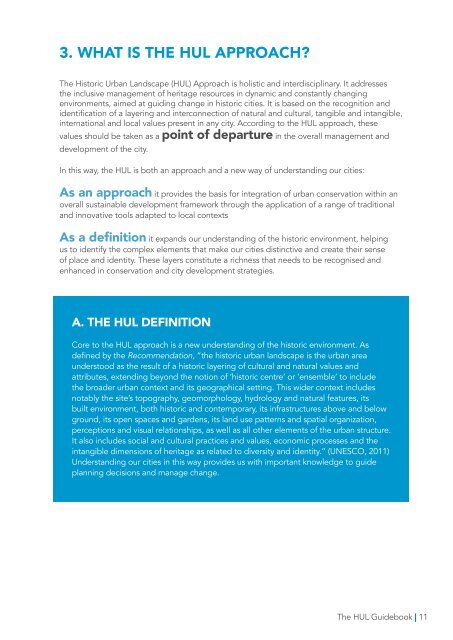GUIDEBOOK
wirey5prpznidqx
wirey5prpznidqx
You also want an ePaper? Increase the reach of your titles
YUMPU automatically turns print PDFs into web optimized ePapers that Google loves.
3. WHAT IS THE HUL APPROACH?<br />
The Historic Urban Landscape (HUL) Approach is holistic and interdisciplinary. It addresses<br />
the inclusive management of heritage resources in dynamic and constantly changing<br />
environments, aimed at guiding change in historic cities. It is based on the recognition and<br />
identification of a layering and interconnection of natural and cultural, tangible and intangible,<br />
international and local values present in any city. According to the HUL approach, these<br />
values should be taken as a point of departure in the overall management and<br />
development of the city.<br />
In this way, the HUL is both an approach and a new way of understanding our cities:<br />
As an approach it provides the basis for integration of urban conservation within an<br />
overall sustainable development framework through the application of a range of traditional<br />
and innovative tools adapted to local contexts<br />
As a definition it expands our understanding of the historic environment, helping<br />
us to identify the complex elements that make our cities distinctive and create their sense<br />
of place and identity. These layers constitute a richness that needs to be recognised and<br />
enhanced in conservation and city development strategies.<br />
A. THE HUL DEFINITION<br />
Core to the HUL approach is a new understanding of the historic environment. As<br />
defined by the Recommendation, “the historic urban landscape is the urban area<br />
understood as the result of a historic layering of cultural and natural values and<br />
attributes, extending beyond the notion of ‘historic centre’ or ‘ensemble’ to include<br />
the broader urban context and its geographical setting. This wider context includes<br />
notably the site’s topography, geomorphology, hydrology and natural features, its<br />
built environment, both historic and contemporary, its infrastructures above and below<br />
ground, its open spaces and gardens, its land use patterns and spatial organization,<br />
perceptions and visual relationships, as well as all other elements of the urban structure.<br />
It also includes social and cultural practices and values, economic processes and the<br />
intangible dimensions of heritage as related to diversity and identity.” (UNESCO, 2011)<br />
Understanding our cities in this way provides us with important knowledge to guide<br />
planning decisions and manage change.<br />
The HUL Guidebook | 11


